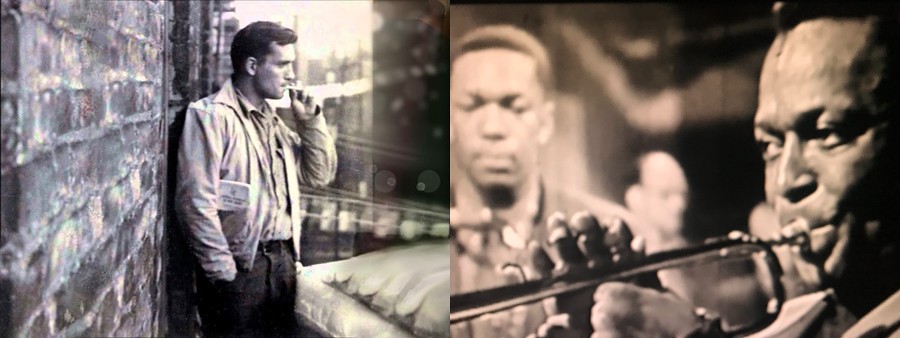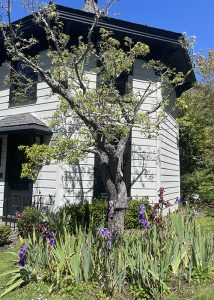We are pleased to present this article by JC Miller, curator of the upcoming exhibition Cool Outside: California’s mid-century landscape. Mr. Miller is a licensed landscape architect, a writer, and an educator. He is a partner at Vallier Design Associates, a landscape architecture and planning practice located in the Bay Area.

Lean and inspired by modern art, the gardens of postwar California were often Cool.
Chinn Garden- San Francisco, CA 1951, Photographer not known, Source: Collection of the Author
When someone or something is described as Cool, what does that mean?
The Merriam Webster dictionary currently provides several definitions ranging from the physical sensation to a situation that is free of tension through the terms “fashionable” and “hip”. While normally a useful reference, in this instance the dictionary is not especially helpful. When writing their introduction to “American Cool”, an exhibition of photographs at the National Portrait Gallery, Joel Dinerstein and co-curator Frank Goodyear suggest that certain individuals who bring innovation and virtuosity while projecting style, charisma and confidence are Cool—that seems closer to what we are after.

Beat poetry and jazz music introduced the American public to the concept of Cool
“What Happened to Jack Kerouac” by Geoth is marked with CC PDM 1.0 ; Miles Davis by rocor is licensed under CC BY-NC 2.0 https://search.creativecommons.org/photos/c2cee427-0e52-4133-ae83-9c6105e6026e
Legendary jazz saxophonist Lester Young is credited with establishing the modern meaning and usage of the word “cool”. In the original context, the jazz music scene of the late 1940’s, to be Cool meant being relaxed in one’s environment despite oppressive social forces such as racism and social injustice. Miles Davis, whose 1949-50 recordings for Capitol Records were released in 1957 under the title “Birth of the Cool”, brought the term to the attention of a broader audience. Davis was in the vanguard of a generation of jazz musicians who went beyond big-band swing to create Bebop, an experimental, energetic, and highly personal virtuosic style. The genius of a Bebop instrumental solo begins with departure from the rhythmic base line, soaring improvisation that takes the music to unexpected heights with eventual return to the basic structure that has been continued uninterrupted by the other musicians. This innovation shifted jazz away from music for dance performed by big bands in large venues to small group or individual performances in intimately scaled nightclubs for an attentive and knowledgeable audience. With this shift the Cool emerged as a form of uniquely American presentation and stoicism, manifested first in jazz music, but also found in film noir, Beat literature, and abstract expressionist painting in the early 1950’s. Through the creative output of these early innovators, a generation of Americans were introduced to Cool.

The sets that sculptor Isamu Noguchi designed for dancer/choreographer Martha Graham
epitomized the collaborative and experimental spirit of fine art in the postwar era.
“Endpapers of Martha Graham” by Crossett Library Bennington College licensed under CC BY-NC-SA 2.0 ; Stage set designed by sculptor Isamu Noguchi for Martha_Graham_Dance_Company_1947_Muziektheater,_Bestanddeelnr_934-2337; Public Domain – This work has been marked as dedicated to the public domain.
There are reciprocal influences within creative circles and through these the Cool moves beyond the realm of musicians, writers, and painters to be picked up and explored by other mid-century creatives, including graphic designers, architects, and landscape architects. Today we might call this viral transmission of information. In this transition the Cool with its fundamental embrace of experimentalism, becomes linked to other ideas prevalent in design thinking at the time, including architectural modernism, innovation in materials, and cross-disciplinary collaboration. The Cool was an emerging concept ideally suited to the changing, experimental, and rapidly expanding built environment in postwar California.

Working with ALCOA, the Aluminum Company of America, Garrett Eckbo developed a garden that demonstrated
how a material developed in wartime might be used in a residential setting.
Alcoa Forecast Garden- Los Angeles, CA 1957, Photographer not known, Source: UC Berkeley College of Environmental Design Archive
In the decades following World War II, the urban population of California grew exponentially. During this period, the state was growing faster than any other in the nation. This boom in growth was nourished by post-war industrial expansion, high-paying jobs, home mortgages supported by the Federal Housing Authority and education opportunities on the GI-Bill. In southern California, Hollywood in particular provided employment and a safe haven for artists and creatives who had fled war in Europe, who carried with them the tenets of international modernism. The most pronounced growth occurred on the edges of existing urban areas, generating suburbs on what had previously been agricultural land. It was the building opportunities spurred on by the concurrent population and economic boom in these newly made communities that allowed the Cool to go outside.

It was often the growing suburbs of midcentury California where the Cool might be found outside.
Eichler X-100, San Mateo, CA 1957, Photographers not known, Source: Eichler Network / CA Modern Magazine

The workplace also offered opportunities for landscape Cool on your lunch break.
Kaiser Center Roof Garden, Oakland, CA 1959, Photographer unknown, Source: UC Berkeley College of Environmental Design Archive
This dynamic period and the people that helped shape the landscape of the period are the subject of Cool Outside, an exhibition hosted at Marin Art and Garden Center. Beginning June 20th and running through August 22nd, 2021 Cool Outside explores a distinct, and certainly Cool, approach to the design of outdoor space and garden furnishings as they developed across California in the 1950s and early 1960s. Photographs and drawings as well as models of now iconic mid-century gardens and landscapes drawn from the collections of the University of California Berkeley College of Environmental Design Archives will be on display, supplemented by period film, garden furniture, pottery, and art.




